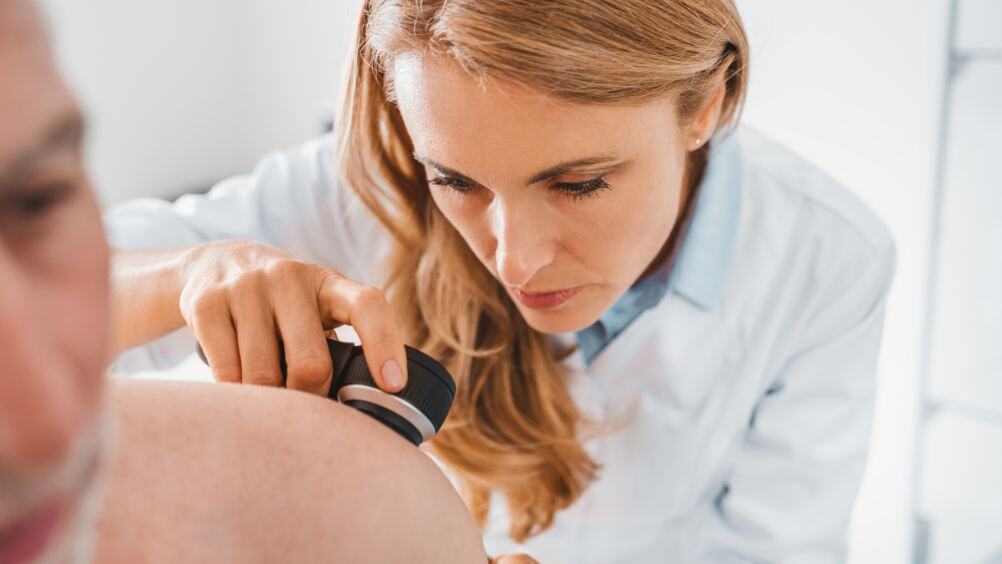It’s important to stay aware of any changes to your skin. While it’s concerning to find a new spot or mole, the reality is that it doesn’t always mean you have skin cancer. Most skin growths never cause a health issue or progress to cancer. However, some of them could turn into cancer over time. Understanding more about precancerous skin growths can help you avoid developing skin cancer in the future.
What Are Precancerous Skin Growths?
Precancerous skin growths are considered abnormal areas of the skin that could turn into cancer if they aren’t removed. Typically, these growths are found on the skin's surface and are generally located in areas regularly exposed to the sun, such as the head, back, shoulders, or hands.
While it’s possible to develop precancerous skin growths at any age, it’s most common among people over 40. Their skin was repeatedly exposed to the sun over the years and is starting to change. If you were born before the mid-1980s, you’re even more likely to develop precancerous growths. Sunscreen wasn’t available before then, which means people in this age group likely experienced damaging sun exposure at a very young age.
What Do Precancerous Skin Growths Look Like?
Precancerous growths on the skin come in many shapes, sizes, and colors. Some examples include unusual bumps, scars, and spots you didn’t have before. You may notice more freckles and dark spots if you're light-skinned. Those are not typically precancerous. Here are some things to look for so you can talk to your doctor:
- The area is slightly raised and less than one inch in diameter.
- The growths are brown, red, pink, gray, yellow, or white and may have a hard or scaly texture.
- Any spots that hurt, burn, or itch.
You don’t have to have all these for the spot to be precancerous. That’s why an annual skin cancer screening is helpful. You can also monitor changes in your skin using an app.
Related reading: 4 Apps That Help Detect Skin Changes That May Lead to Skin Cancer
Types of Skin Changes that Could Be Precancerous
- Actinic Keratosis (AK): AK often presents as small, scaly, or crusty patches that can be pink, red, or have various colors throughout the lesion. These patches may feel rough, resembling sandpaper on the skin.

- Moles: These brown or black skin growths can appear anywhere on the skin. They typically emerge in early childhood and can continue developing through young adulthood (up to age 25). Moles usually change very slowly but can become raised or change color. Some moles may always stay the same or may even disappear over time.

- Atypical Moles (Dysplastic Nevi): Generally larger and differently shaped than regular moles, atypical moles are considered unusual. New moles appearing after age 25 can also be classified as atypical.

Spots or Changes in Your Skin That Are Not Likely Precancerous
You might have other noticeable growths or marks on your body. Most of these are harmless and not a cause for concern. These can include:
- Skin Tags: small flaps of tissue that hang off the skin. They are commonly found on the neck, chest, armpits, groin area, or under the breasts. Skin tags are more common in overweight women and older adults. They often become noticeable when irritated by clothing or skin rubbing against them.
- Freckles: small brown spots on the face, neck, chest, and arms. They are often more visible in light-skinned individuals or those with light or red hair. Freckles typically become more prominent with sun exposure, especially during summer.
- Age Spots (Lentigines): brown skin discolorations commonly caused by sun exposure and more frequent among fair-skinned individuals. Some age spots are hereditary or caused by radiation therapy. They often appear in clusters, have smooth borders, and are painless.
- Warts (Seborrheic Keratoses): usually brown, tan, or black and are found on the chest, back, and head. They become more common with age but rarely develop into skin cancer.
Speak with Your Doctor About Skin Changes
If you find a precancerous skin growth, the next step is to discuss recommendations with your primary care physician or dermatologist regarding how to treat this spot and prevent future spots from developing into cancer.
Early detection is so important. If you notice any changes in your skin, you should schedule a consultation with your doctor immediately. Some changes you should report include:
- An existing mole that has started to grow or spread
- Bleeding or swelling on the skin
- A sore that won’t heal
- Any new growths on the skin that match the types of skin changes that could be precancerous
Treatments for skin changes can vary, including medications, total removal through freezing, light therapy, or an in-office surgical procedure. Cells removed during the process may be tested to see if they show signs of cancer.
How to Check Your Body for Skin Cancer
Skin cancer can develop in any area of the body. However, it is most likely to develop in the regions more commonly exposed to the sun, such as the face, head, neck, arms, or legs.
Squamous cell cancers may look like this:
- Scaly red patches that may bleed
- Raised lumps or growths
- Sores that don’t heal or heal and return
- Wart-like appearance
Basal cell cancers typically have these features:
- Looks scar-like and has a yellow tint
- Raised reddish patch
- Shiny bump that may also have discoloration
- Pinkish growth with raised edges
- A sore that doesn’t heal
Melanoma can look like:
- A new spot on the skin that changes in shape, size, or color
- A spot that looks very different from other spots on your body
.jpg?width=1000&height=692&name=Cancer-Skin-Cancer-Types%20(1).jpg)
Skin cancer signs and symptoms can vary from person to person. If you notice any changes, it is worth contacting your doctor to ensure there is nothing to be concerned about. Watch the video below to learn the ABCDE rule for detecting skin cancer.
Reduce Your Risk of Skin Cancer
Protecting your skin is the best way to reduce your risk of skin cancer. You can do this by reducing your exposure to the sun. If you are outdoors, wear proper clothing, hats, and sunglasses, and try to stay in the shade as much as possible. Of course, you should also wear sunscreen with at least 30 SPF – even on cloudy days. While many Oregon residents are used to overcast and rainy days, remember to wear sunscreen as you can still be exposed to harmful UV rays even if the sun isn’t directly out. You should also avoid tanning beds and make sure you schedule regular skin screenings if you are over 40.
Related Reading: 4 Practical Tips for Lowering Skin Cancer Risk
Do Not Skip Your Skin Cancer Screenings
While self-exams are helpful, your doctor can provide a more thorough exam. Regular skin cancer screenings ensure your skin is healthy and cancer-free.
If screening results come back abnormal or if you received a diagnosis of skin cancer, the skin cancer doctors at Willamette Valley Cancer Institute provide treatment for non-melanoma and melanoma skin cancers at locations in Albany, Corvallis, Eugene, Florence, Lincoln City, and Newport, Oregon. Request a consultation with one of our skin oncologists to learn about your specific diagnosis and the next steps for treatment.


